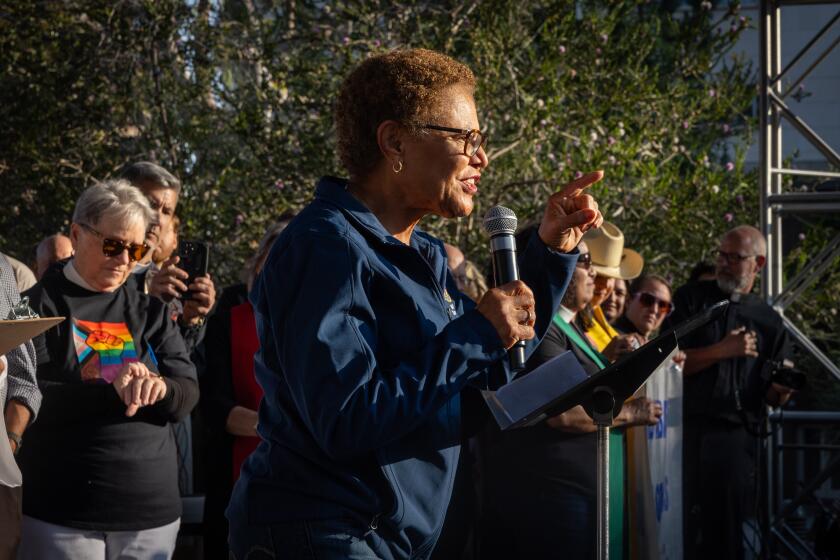L.A.’s maturing mayor
- Share via
Dismay and disappointment probably would best describe even sympathetic observers’ reaction to Mayor Antonio Villaraigosa’s first term in office.
There were some achievements — most notably, the consolidation of meaningful police reform and the passage of Measure R, the sales tax increase to fund a major expansion of public transit. The former, however, began in earnest under Villaraigosa’s predecessor, James Hahn, and though the mayor’s vision and leadership were key to persuading two-thirds of the county’s voters to approve Measure R, so were the efforts of Supervisor Zev Yaroslavsky and others.
Overall, the record Villaraigosa put before the voters when he stood for reelection was that of a frenetic executive, distracted and apparently moving in too many directions, long on rhetoric and painfully short on follow-through.
Now, a year into his second term, Villaraigosa has rediscovered one his greatest political strengths: a willingness to reexamine the received rules and to discard those that no longer serve their purpose, even when they’re ones by which he’s lived. As a consequence, remarkable things have begun to happen.
One of those is the too-little-remarked-on agreement that recently settled a civil rights lawsuit brought against the Los Angeles Unified School District by the ACLU, Public Counsel and Morrison & Foerster, acting at Villaraigosa’s invitation. Under the terms of that settlement, L.A. Unified agreed that its practice of conducting teacher layoffs according to strict seniority created a hardship for students in the most disadvantaged schools so severe that it amounts to a deprivation of rights. That’s because a disproportionate number of the most dedicated teachers in those schools are young and fresh to their jobs, and, therefore, were the first to be laid off by the district.
All three of the plaintiffs in the suit — Edwin Markham, Samuel Gompers and John H. Liechty middle schools — are part of Villaraigosa’s Partnership for Los Angeles Schools, which now encompasses 22,000 students on 21 of the district’s worst-performing campuses.
I saw some of the results this week when I accompanied Villaraigosa to Gompers. Like the community it’s in, the school is about 70% Latino and 20% African American. Close to half the students live with a caregiver other than a parent. When the partnership took it over, there had been eight principals in nine years; five of the bathrooms hadn’t worked for most of that time. The student lockers that lined interior hallways were covered in graffiti. Over the prior three years, according to principal Sonia Miller, 75% of the teaching staff had turned over.
Today, Gompers physically sparkles and fairly crackles with energy. Miller took her job because she believes inner-city children have a right to a high-quality education, “and I enjoy coming to work every day.”
It’s a sentiment three of her teachers echo when they describe how, even though they’re union members, they’re willing to forgo the traditional protections of the seniority system to bring stability to Gompers’ students. Sara Talley, the young mother of a 2-year-old, was willing to become a substitute teacher rather than leave when her layoff notice came; Orlando Johnson, himself a product of L.A. schools and UCLA, had to enlist a vice principal to explain to his wife why she and their three young children should let him take a pay cut to stay at Gompers. Kenneth Aubrey, a middle-aged veteran teacher, didn’t face a layoff, but he is willing to give up the protection of seniority because he doesn’t want to “send a message to these students that, like the rest of society, we think they’re disposable, that our interests come before theirs.”
Villaraigosa calls equal education for inner-city students “the civil rights issue of our times.” As an old United Teachers Los Angeles organizer and a politician whose deepest base of support always has been in organized labor, he’s nonetheless willing to take on his former union over one of its sacred cows because he feels the times “and a commitment to social justice” require it.
Like his visionary 30/10 transit initiative that seeks to use the tax revenues from Measure R to secure innovative federal funding to build three decades of transit projects in one, Villaraigosa’s willingness to take on blind loyalty to teacher seniority signals a willingness to rewrite rules that have outlived their purpose.
If he can apply similar critical thinking to the issue of public employee pensions and benefits, he may yet leave a remarkable legacy.
More to Read
Sign up for Essential California
The most important California stories and recommendations in your inbox every morning.
You may occasionally receive promotional content from the Los Angeles Times.













